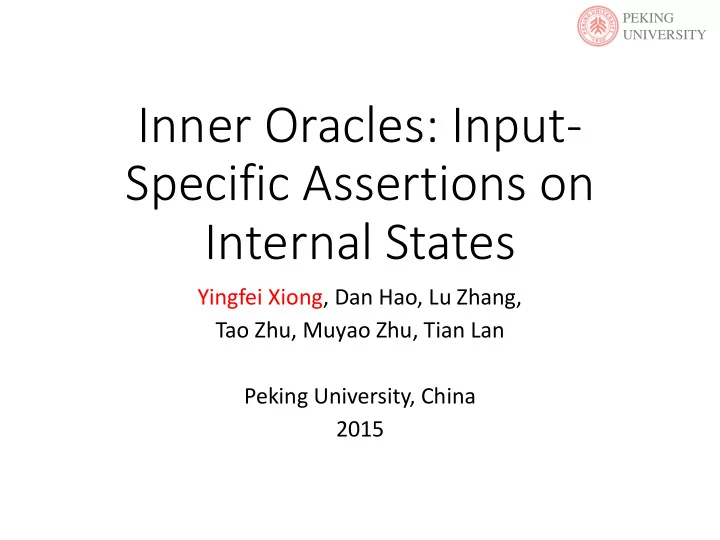

PEKING UNIVERSITY Inner Oracles: Input- Specific Assertions on Internal States Yingfei Xiong, Dan Hao, Lu Zhang, Tao Zhu, Muyao Zhu, Tian Lan Peking University, China 2015
PEKING How a Test Detects a Bug UNIVERSITY Test Input Trigger a Bug Buggy State Propagate the state Buggy Output Check the oracle Find the bug!
PEKING How a Test Not Detects a Bug UNIVERSITY Test a = {-2, -1, 0, 1, 2, 3, 4}; int compare(List<Integer> a) { Input int pos = 0, neg = 0; for (int i : a) { Trigger a if (i > 0) pos++; Bug else neg++; //buggy } Buggy buggy State pos = 4 neg = 3 if (pos > neg) return 1; Propagate else if (pos == neg) return 0; the state else return -1; } not buggy Buggy Output compare(a)=1 Check the oracle assert(compare(a)==1); Find the bug! No bug
PEKING Traditional Oracles UNIVERSITY Test a = {-2, -1, 0, 1, 2, 3, 4}; int compare(List<Integer> a) { Input int pos = 0, neg = 0; for (int i : a) { Trigger a if (i > 0) pos++; Bug else neg++; //buggy } Buggy buggy State pos = 4 neg = 3 if (pos > neg) return 1; Propagate else if (pos == neg) return 0; the state else return -1; } not buggy Buggy Output compare(a)=1 Traditional Oracles Check the Specific to one test input oracle assert(compare(a)==1); Declared on the output of the execution Find the bug! No bug
PEKING Assertions on Internal State UNIVERSITY Test a = {-2, -1, 0, 1, 2, 3, 4}; int compare(List<Integer> a) { Input int pos = 0, neg = 0; for (int i : a) { Trigger a if (i > 0) pos++; Bug else neg++; //buggy } Buggy State pos = 4 neg = 3 Propagate assert(neg == the state /*number of negatives*/); Buggy if (pos > neg) return 1; Output else if (pos == neg) return 0; Standard Assertions else return -1; • on internal states Check the } • common to all input oracle • Not easy to write • Programmers may make the same Find the mistake bug!
PEKING Inner Oracles UNIVERSITY Test a = {-2, -1, 0, 1, 2, 3, 4}; int compare(List<Integer> a) { Input int pos = 0, neg = 0; for (int i : a) { Trigger a if (i > 0) pos++; Bug else neg++; //buggy } Buggy State pos = 4 neg = 3 Propagate assert_for_this_test( the state neg == 2); Buggy if (pos > neg) return 1; Output else if (pos == neg) return 0; Inner Oracles else return -1; • Declared on internal states Check the } • Specific to a test input oracle Find the bug!
PEKING UNIVERSITY How to write inner oracles int compare(List<Integer> a) { class CountTest { int pos = 0, neg = 0; public static boolean guard = false; for (int i : a) { if (i > 0) pos++; @Test public void test1() { else neg++; //buggy List<Integer> a = {-2, -1, 0, 1, 2, 3, 4}; } guard = true; assert (!CountTest.guard || compare(a); neg == 2); if (pos > neg) return 1; guard = false; } else if (pos == neg) return 0; } else return -1; } Inner oracles can also be written by weaving, similar to AOP. Check at: http://ayzk.github.io/InnerTest/
PEKING UNIVERSITY How much can we gain with inner oracles? – Enhancing tests In 30.72%-69.65% pairs, fault cannot be captured by traditional oracles on output, but only by inner oracles. The buggy state is not propagated into a buggy output (294/1369) The buggy part in the output state cannot be accessed by a test, e.g., a private member (1075/1369)
PEKING UNIVERSITY How much can we gain with inner oracles? – Reducing test suites Test suites are further reduced by 14.3%-50.0% with inner oracles.
PEKING UNIVERSITY Applications and Implications --- Testing Optimization int times(int a, int b) { if (b % 2 == 0) { How do we know the first while (b >>= 1) branch is executed when return a << 1; b is 8? } else return a * b; }
PEKING UNIVERSITY Applications and Implications --- Testing Optimization int times(int a, int b) { if (b % 2 == 0) { while (b >>= 1) test1 = true; times(2, 8); return a << 1; test1 = false; } else { assert(!test1); return a * b; }}
PEKING UNIVERSITY Applications and Implications --- Debugging Traditional Oracles • Any executed statements may be buggy Inner Oracles • Only the statements executed before the inner oracle may be buggy
PEKING UNIVERSITY Applications and Implications --- Regression Test Generation doStuff(X x, int n, int m) { @Test Y y = x.doSth(n); … Z z = y.doSthElse(m); doStuff(x, 1, 2); z.field = n+m; assert(z.filed == 3); return; } How do we know which object z is? How do we access this object? [Xie et al., ECOOP06], [Taneja et al., ASE08]
PEKING UNIVERSITY Applications and Implications --- Regression Test Generation doStuff(X x, int n, int m) { @Test Y y = x.doSth(n); … Z z = y.doSthElse(m); test1 = true; z.field = n+m; doStuff(x, 1, 2); assert(!test1 || z.field==3); test1 = false; return; }
PEKING UNIVERSITY Application and Implication --- Invariant Discovery • Tools like Daikon discovers invariants (oracles on internal states for all inputs) • Sometimes very few invariants can be discovered if we use too many inputs • Let Daikon discover inner oracles for some inputs instead test1 = true; test1 = true; test1 = true; doStuff(1); doStuff(2); doStuff(3); test1 = false; test1 = false; test1 = false;
PEKING UNIVERSITY Summary • Inner Oracles • declared on internal states • specific to one test input • Has a lot of applications/implications • Ignored in existing literatures • Worth putting more weights on
Recommend
More recommend